(完整)语言学名词解释
- 格式:pdf
- 大小:20.27 KB
- 文档页数:9
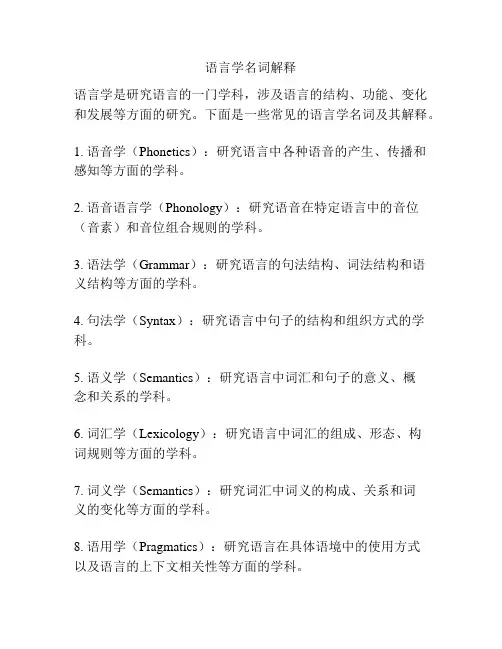
语言学名词解释语言学是研究语言的一门学科,涉及语言的结构、功能、变化和发展等方面的研究。
下面是一些常见的语言学名词及其解释。
1. 语音学(Phonetics):研究语言中各种语音的产生、传播和感知等方面的学科。
2. 语音语言学(Phonology):研究语音在特定语言中的音位(音素)和音位组合规则的学科。
3. 语法学(Grammar):研究语言的句法结构、词法结构和语义结构等方面的学科。
4. 句法学(Syntax):研究语言中句子的结构和组织方式的学科。
5. 语义学(Semantics):研究语言中词汇和句子的意义、概念和关系的学科。
6. 词汇学(Lexicology):研究语言中词汇的组成、形态、构词规则等方面的学科。
7. 词义学(Semantics):研究词汇中词义的构成、关系和词义的变化等方面的学科。
8. 语用学(Pragmatics):研究语言在具体语境中的使用方式以及语言的上下文相关性等方面的学科。
9. 文法学(Stylistics):研究语言使用中的文体、修辞手法、语言风格等方面的学科。
10. 母语(Mother tongue):一个人从小学会并用于日常交际的语言。
11. 第二语言(Second language):在学习者的母语之外学习的语言。
12. 语言接触(Language contact):不同语言之间在社会、文化接触中产生的相互影响和借用的现象。
13. 语言变异(Language variation):指同一个语言在不同社会、地理和使用者间发生的音、词、句法等方面的变化。
14. 语言变化(Language change):指语言在漫长的时间内逐渐变化和发展的过程。
15. 语言规范(Language standardization):制定和规范一个语言的正确用法、标准词汇和语法规则的过程。
16. 语言习得(Language acquisition):指儿童在自然环境中学习母语的过程。
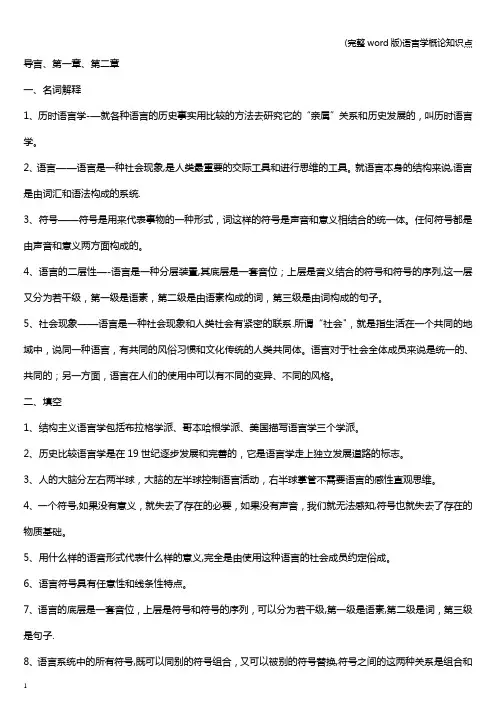
导言、第一章、第二章一、名词解释1、历时语言学-—就各种语言的历史事实用比较的方法去研究它的“亲属”关系和历史发展的,叫历时语言学。
2、语言——语言是一种社会现象,是人类最重要的交际工具和进行思维的工具。
就语言本身的结构来说,语言是由词汇和语法构成的系统.3、符号——符号是用来代表事物的一种形式,词这样的符号是声音和意义相结合的统一体。
任何符号都是由声音和意义两方面构成的。
4、语言的二层性—-语言是一种分层装置,其底层是一套音位;上层是音义结合的符号和符号的序列,这一层又分为若干级,第一级是语素,第二级是由语素构成的词,第三级是由词构成的句子。
5、社会现象——语言是一种社会现象和人类社会有紧密的联系.所谓“社会",就是指生活在一个共同的地域中,说同一种语言,有共同的风俗习惯和文化传统的人类共同体。
语言对于社会全体成员来说是统一的、共同的;另一方面,语言在人们的使用中可以有不同的变异、不同的风格。
二、填空1、结构主义语言学包括布拉格学派、哥本哈根学派、美国描写语言学三个学派。
2、历史比较语言学是在19世纪逐步发展和完善的,它是语言学走上独立发展道路的标志。
3、人的大脑分左右两半球,大脑的左半球控制语言活动,右半球掌管不需要语言的感性直观思维。
4、一个符号,如果没有意义,就失去了存在的必要,如果没有声音,我们就无法感知,符号也就失去了存在的物质基础。
5、用什么样的语音形式代表什么样的意义,完全是由使用这种语言的社会成员约定俗成。
6、语言符号具有任意性和线条性特点。
7、语言的底层是一套音位,上层是符号和符号的序列,可以分为若干级,第一级是语素,第二级是词,第三级是句子.8、语言系统中的所有符号,既可以同别的符号组合,又可以被别的符号替换,符号之间的这两种关系是组合和聚合。
9、组合是指符号与符号相互之间在功能上的联系,聚合是指符号在性质上的归类。
三、判断正误(正确的打钩,错误的打叉)1、文字是人类最重要的交际工具。
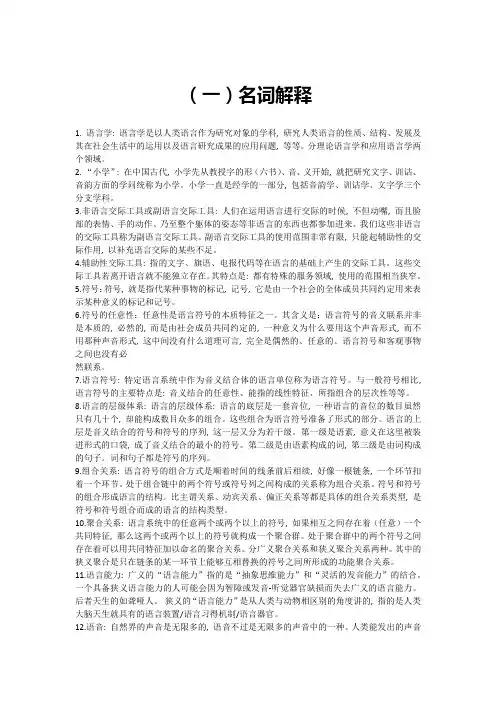
(一)名词解释1. 语言学: 语言学是以人类语言作为研究对象的学科, 研究人类语言的性质、结构、发展及其在社会生活中的运用以及语言研究成果的应用问题, 等等。
分理论语言学和应用语言学两个领域。
2. “小学”: 在中国古代, 小学先从教授字的形(六书)、音、义开始, 就把研究文字、训诂、音韵方面的学问统称为小学。
小学一直是经学的一部分, 包括音韵学、训诂学、文字学三个分支学科。
3.非语言交际工具或副语言交际工具: 人们在运用语言进行交际的时候, 不但动嘴, 而且脸部的表情、手的动作、乃至整个躯体的姿态等非语言的东西也都参加进来。
我们这些非语言的交际工具称为副语言交际工具。
副语言交际工具的使用范围非常有限, 只能起辅助性的交际作用, 以补充语言交际的某些不足。
4.辅助性交际工具: 指的文字、旗语、电报代码等在语言的基础上产生的交际工具。
这些交际工具若离开语言就不能独立存在。
其特点是: 都有特殊的服务领域, 使用的范围相当狭窄。
5.符号:符号, 就是指代某种事物的标记, 记号, 它是由一个社会的全体成员共同约定用来表示某种意义的标记和记号。
6.符号的任意性:任意性是语言符号的本质特征之一。
其含义是:语言符号的音义联系并非是本质的, 必然的, 而是由社会成员共同约定的, 一种意义为什么要用这个声音形式, 而不用那种声音形式, 这中间没有什么道理可言, 完全是偶然的、任意的。
语言符号和客观事物之间也没有必然联系。
7.语言符号: 特定语言系统中作为音义结合体的语言单位称为语言符号。
与一般符号相比, 语言符号的主要特点是: 音义结合的任意性、能指的线性特征、所指组合的层次性等等。
8.语言的层级体系: 语言的层级体系: 语言的底层是一套音位, 一种语言的音位的数目虽然只有几十个, 却能构成数目众多的组合。
这些组合为语言符号准备了形式的部分。
语言的上层是音义结合的符号和符号的序列, 这一层又分为若干级。
第一级是语素, 意义在这里被装进形式的口袋, 成了音义结合的最小的符号。
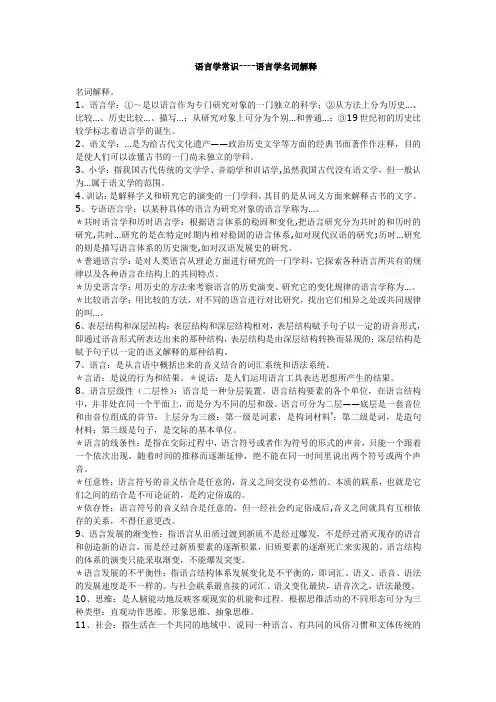
语言学常识----语言学名词解释名词解释。
1、语言学:①~是以语言作为专门研究对象的一门独立的科学;②从方法上分为历史…、比较…、历史比较…、描写…;从研究对象上可分为个别…和普通…;③19世纪初的历史比较学标志着语言学的诞生。
2、语文学:…是为给古代文化遗产——政治历史文学等方面的经典书面著作作注释,目的是使人们可以读懂古书的一门尚未独立的学科。
3、小学:指我国古代传统的文学学、音韵学和训诂学,虽然我国古代没有语文学,但一般认为…属于语文学的范围。
4、训诂:是解释字义和研究它的演变的一门学科,其目的是从词义方面来解释古书的文字。
5、专语语言学:以某种具体的语言为研究对象的语言学称为…。
*共时语言学和历时语言学:根据语言体系的稳固和变化,把语言研究分为共时的和历时的研究,共时…研究的是在特定时期内相对稳固的语言体系,如对现代汉语的研究;历时…研究的则是描写语言体系的历史演变,如对汉语发展史的研究。
*普通语言学:是对人类语言从理论方面进行研究的一门学科,它探索各种语言所共有的规律以及各种语言在结构上的共同特点。
*历史语言学:用历史的方法来考察语言的历史演变、研究它的变化规律的语言学称为…。
*比较语言学:用比较的方法,对不同的语言进行对比研究,找出它们相异之处或共同规律的叫…。
6、表层结构和深层结构:表层结构和深层结构相对,表层结构赋予句子以一定的语音形式,即通过语音形式所表达出来的那种结构,表层结构是由深层结构转换而显现的;深层结构是赋予句子以一定的语义解释的那种结构。
7、语言:是从言语中概括出来的音义结合的词汇系统和语法系统。
*言语:是说的行为和结果。
*说话:是人们运用语言工具表达思想所产生的结果。
8、语言层级性(二层性):语言是一种分层装置。
语言结构要素的各个单位,在语言结构中,并非处在同一个平面上,而是分为不同的层和级。
语言可分为二层——底层是一套音位和由音位组成的音节;上层分为三级:第一级是词素,是构词材料';第二级是词,是造句材料;第三级是句子,是交际的基本单位。
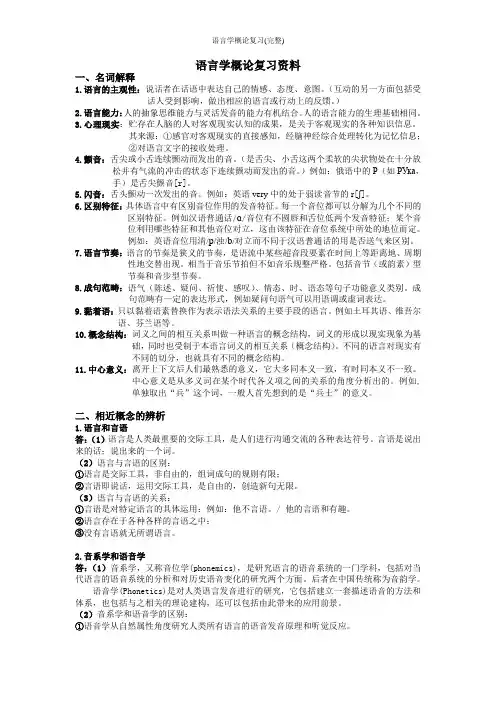
语言学概论复习资料一、名词解释1.语言的主观性:说话者在话语中表达自己的情感、态度、意图。
(互动的另一方面包括受话人受到影响,做出相应的语言或行动上的反馈。
)2.语言能力:人的抽象思维能力与灵活发音的能力有机结合。
人的语言能力的生理基础相同。
3.心理现实:贮存在人脑的人对客观现实认知的成果,是关于客观现实的各种知识信息。
其来源:①感官对客观现实的直接感知,经脑神经综合处理转化为记忆信息;②对语言文字的接收处理。
4.颤音:舌尖或小舌连续颤动而发出的音。
(是舌尖、小舌这两个柔软的尖状物处在十分放松并有气流的冲击的状态下连续颤动而发出的音。
)例如:俄语中的Р(如РУка,手)是舌尖颤音[r]。
5.闪音:舌头颤动一次发出的音。
例如:英语very中的处于弱读音节的r[ʃ]。
6.区别特征:具体语言中有区别音位作用的发音特征。
每一个音位都可以分解为几个不同的区别特征。
例如汉语普通话/ɑ/音位有不圆唇和舌位低两个发音特征;某个音位利用哪些特征和其他音位对立,这由该特征在音位系统中所处的地位而定。
例如:英语音位用清/p/浊/b/对立而不同于汉语普通话的用是否送气来区别。
7.语言节奏:语言的节奏是狭义的节奏,是语流中某些超音段要素在时间上等距离地、周期性地交替出现。
相当于音乐节拍但不如音乐规整严格。
包括音节(或韵素)型节奏和音步型节奏。
8.成句范畴:语气(陈述、疑问、祈使、感叹)、情态、时、语态等句子功能意义类别。
成句范畴有一定的表达形式,例如疑问句语气可以用语调或虚词表达。
9.黏着语:只以黏着语素替换作为表示语法关系的主要手段的语言。
例如土耳其语、维吾尔语、芬兰语等。
10.概念结构:词义之间的相互关系叫做一种语言的概念结构,词义的形成以现实现象为基础,同时也受制于本语言词义的相互关系(概念结构)。
不同的语言对现实有不同的切分,也就具有不同的概念结构。
11.中心意义:离开上下文后人们最熟悉的意义,它大多同本义一致,有时同本义不一致。
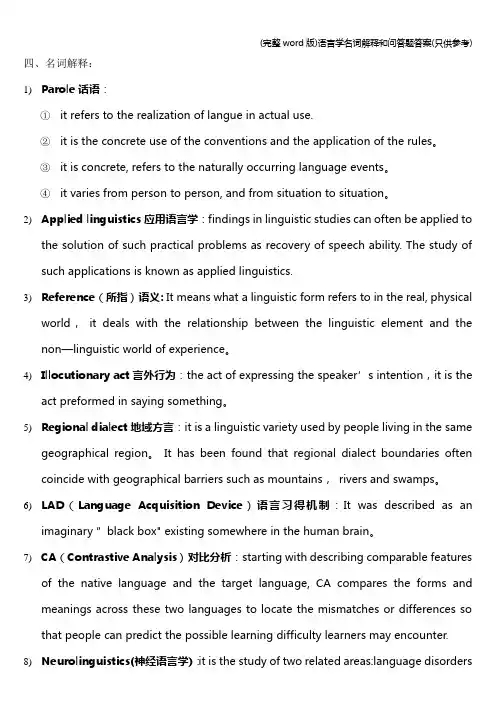
四、名词解释:1)Parole话语:①it refers to the realization of langue in actual use.②it is the concrete use of the conventions and the application of the rules。
③it is concrete, refers to the naturally occurring language events。
④it varies from person to person, and from situation to situation。
2)Applied linguistics应用语言学:findings in linguistic studies can often be applied tothe solution of such practical problems as recovery of speech ability. The study of such applications is known as applied linguistics.3)Reference(所指)语义: It means what a linguistic form refers to in the real, physicalworld,it deals with the relationship between the linguistic element and the non—linguistic world of experience。
4)Illocutionary act言外行为:the act of expressing the speaker’s intention,it is theact preformed in saying something。
5)Regional dialect地域方言:it is a linguistic variety used by people living in the samegeographical region。
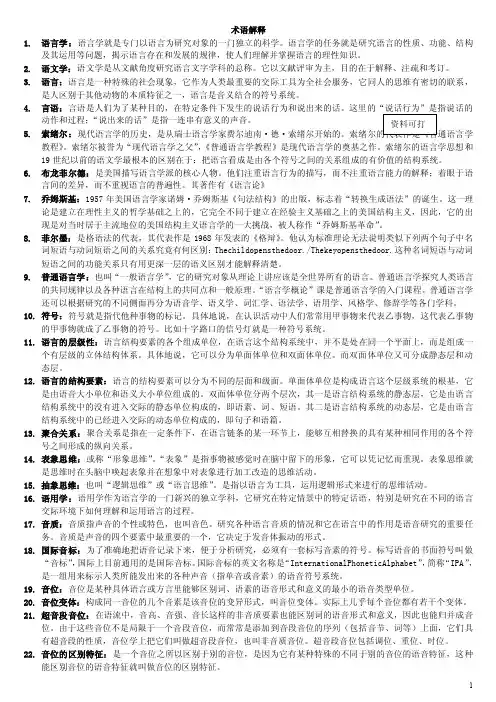
术语解释1.语言学:语言学就是专门以语言为研究对象的一门独立的科学。
语言学的任务就是研究语言的性质、功能、结构及其运用等问题,揭示语言存在和发展的规律,使人们理解并掌握语言的理性知识。
2.语文学:语文学是从文献角度研究语言文字学科的总称。
它以文献评审为主,目的在于解释、注疏和考订。
3.语言:语言是一种特殊的社会现象,它作为人类最重要的交际工具为全社会服务,它同人的思维有密切的联系,是人区别于其他动物的本质特征之一,语言是音义结合的符号系统。
4.言语:言语是人们为了某种目的,在特定条件下发生的说话行为和说出来的话。
这里的“说话行为”是指说话的5.索绪尔:教程》。
索绪尔被誉为“现代语言学之父”,《普通语言学教程》是现代语言学的奠基之作。
索绪尔的语言学思想和19世纪以前的语文学最根本的区别在于:把语言看成是由各个符号之间的关系组成的有价值的结构系统。
6.布龙菲尔德:是美国描写语言学派的核心人物。
他们注重语言行为的描写,而不注重语言能力的解释;着眼于语言间的差异,而不重视语言的普遍性。
其著作有《语言论》7.乔姆斯基:1957年美国语言学家诺姆·乔姆斯基《句法结构》的出版,标志着“转换生成语法”的诞生。
这一理论是建立在理性主义的哲学基础之上的,它完全不同于建立在经验主义基础之上的美国结构主义,因此,它的出现是对当时居于主流地位的美国结构主义语言学的一大挑战,被人称作“乔姆斯基革命”。
8.菲尔墨:是格语法的代表,其代表作是1968年发表的《格辩》。
他认为标准理论无法说明类似下列两个句子中名词短语与动词短语之间的关系究竟有何区别:Thechildopensthedoor./Thekeyopensthedoor.这种名词短语与动词短语之间的功能关系只有用更深一层的语义区别才能解释清楚。
9.普通语言学:也叫“一般语言学”,它的研究对象从理论上讲应该是全世界所有的语言。
普通语言学探究人类语言的共同规律以及各种语言在结构上的共同点和一般原理。
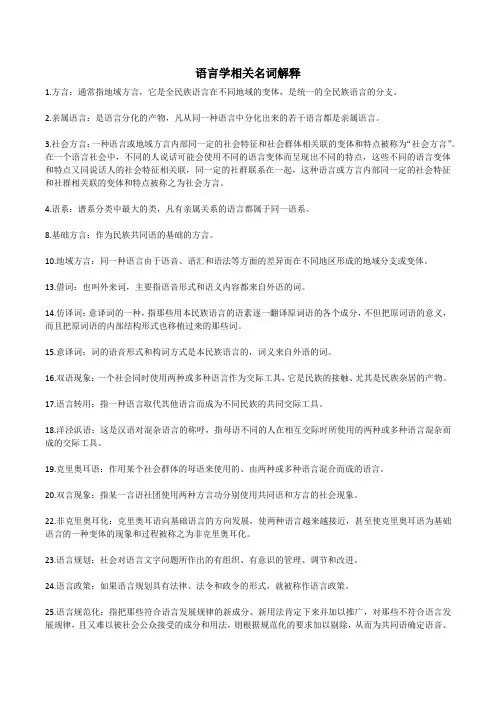
语言学相关名词解释1.方言:通常指地域方言,它是全民族语言在不同地域的变体,是统一的全民族语言的分支。
2.亲属语言:是语言分化的产物,凡从同一种语言中分化出来的若干语言都是亲属语言。
3.社会方言:一种语言或地域方言内部同一定的社会特征和社会群体相关联的变体和特点被称为“社会方言”。
在一个语言社会中,不同的人说话可能会使用不同的语言变体而呈现出不同的特点,这些不同的语言变体和特点又同说话人的社会特征相关联,同一定的社群联系在一起,这种语言或方言内部同一定的社会特征和社群相关联的变体和特点被称之为社会方言。
4.语系:谱系分类中最大的类,凡有亲属关系的语言都属于同一语系。
8.基础方言:作为民族共同语的基础的方言。
10.地域方言:同一种语言由于语音、语汇和语法等方面的差异而在不同地区形成的地域分支或变体。
13.借词:也叫外来词,主要指语音形式和语义内容都来自外语的词。
14.仿译词:意译词的一种,指那些用本民族语言的语素逐一翻译原词语的各个成分,不但把原词语的意义,而且把原词语的内部结构形式也移植过来的那些词。
15.意译词:词的语音形式和构词方式是本民族语言的,词义来自外语的词。
16.双语现象:一个社会同时使用两种或多种语言作为交际工具,它是民族的接触、尤其是民族杂居的产物。
17.语言转用:指一种语言取代其他语言而成为不同民族的共同交际工具。
18.洋泾浜语:这是汉语对混杂语言的称呼,指母语不同的人在相互交际时所使用的两种或多种语言混杂而成的交际工具。
19.克里奥耳语:作用某个社会群体的母语来使用的、由两种或多种语言混合而成的语言。
20.双言现象:指某一言语社团使用两种方言功分别使用共同语和方言的社会现象。
22.非克里奥耳化:克里奥耳语向基础语言的方向发展,使两种语言越来越接近,甚至使克里奥耳语为基础语言的一种变体的现象和过程被称之为非克里奥耳化。
23.语言规划:社会对语言文字问题所作出的有组织、有意识的管理、调节和改进。
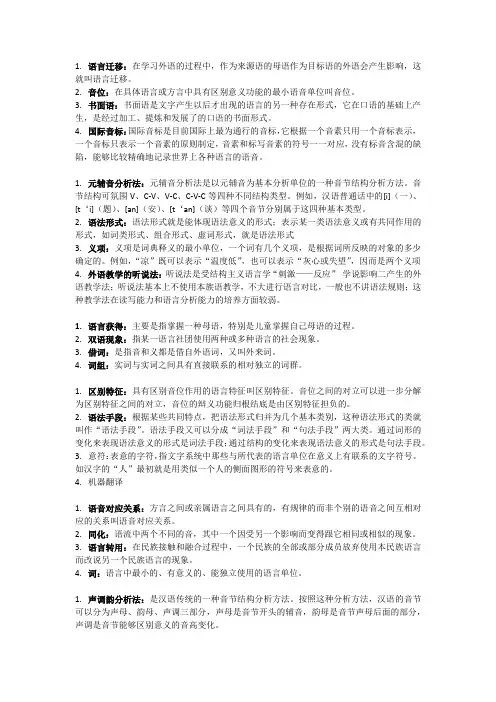
1.语言迁移:在学习外语的过程中,作为来源语的母语作为目标语的外语会产生影响,这就叫语言迁移。
2.音位:在具体语言或方言中具有区别意义功能的最小语音单位叫音位。
3.书面语:书面语是文字产生以后才出现的语言的另一种存在形式,它在口语的基础上产生,是经过加工、提炼和发展了的口语的书面形式。
4.国际音标:国际音标是目前国际上最为通行的音标,它根据一个音素只用一个音标表示,一个音标只表示一个音素的原则制定,音素和标写音素的符号一一对应,没有标音含混的缺陷,能够比较精确地记录世界上各种语言的语音。
1.元辅音分析法:元辅音分析法是以元辅音为基本分析单位的一种音节结构分析方法。
音节结构可氛围V、C-V、V-C、C-V-C等四种不同结构类型。
例如,汉语普通话中的[i](一)、[t‘i](题)、[an](安)、[t‘an](谈)等四个音节分别属于这四种基本类型。
2.语法形式:语法形式就是能体现语法意义的形式;表示某一类语法意义或有共同作用的形式,如词类形式、组合形式、虚词形式,就是语法形式3.义项:义项是词典释义的最小单位,一个词有几个义项,是根据词所反映的对象的多少确定的。
例如,“凉”既可以表示“温度低”,也可以表示“灰心或失望”,因而是两个义项4.外语教学的听说法:听说法是受结构主义语言学“刺激——反应”学说影响二产生的外语教学法;听说法基本上不使用本族语教学,不大进行语言对比,一般也不讲语法规则;这种教学法在读写能力和语言分析能力的培养方面较弱。
1.语言获得:主要是指掌握一种母语,特别是儿童掌握自己母语的过程。
2.双语现象:指某一语言社团使用两种或多种语言的社会现象。
3.借词:是指音和义都是借自外语词,又叫外来词。
4.词组:实词与实词之间具有直接联系的相对独立的词群。
1.区别特征:具有区别音位作用的语言特征叫区别特征。
音位之间的对立可以进一步分解为区别特征之间的对立,音位的辩义功能归根结底是由区别特征担负的。
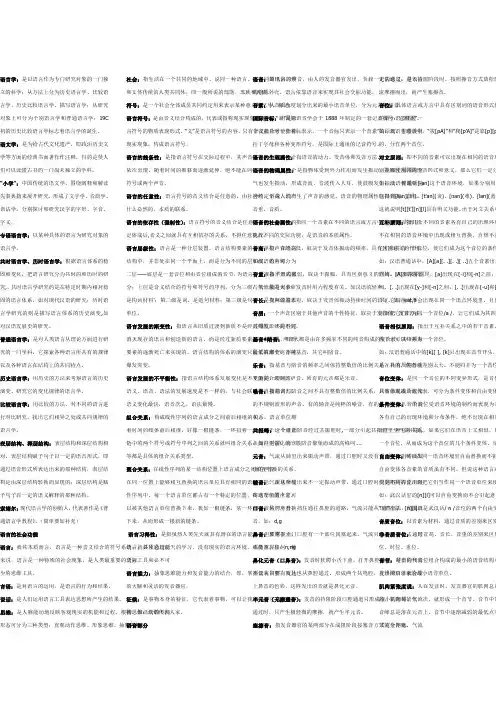
语言学:是以语言作为专门研究对象的一门独立的科学;从方法上分为历史语言学、比较语言学、历史比较语言学、描写语言学;从研究对象上可分为个别语言学和普通语言学;19C 初的历史比较语言学标志着语言学的诞生。
语文学:是为给古代文化遗产,即政治历史文学等方面的经典书面著作作注释,目的是使人们可以读懂古书的一门尚未独立的学科。
“小学”:中国传统的语文学,围绕阐释和解读先秦典籍来展开研究,形成了文字学、音韵学、训诂学,分别探讨和研究汉字的字形、字音、字义。
专语语言学:以某种具体的语言为研究对象的语言学。
共时语言学、历时语言学:根据语言体系的稳固和变化,把语言研究分为共时的和历时的研究,。
共时语言学研究的是在特定时期内相对稳固的语言体系,如对现代汉语的研究;历时语言学研究的则是描写语言体系的历史演变,如对汉语发展史的研究。
普通语言学:是对人类语言从理论方面进行研究的一门学科,它探索各种语言所共有的规律以及各种语言在结构上的共同特点。
历史语言学:用历史的方法来考察语言的历史演变、研究它的变化规律的语言学。
比较语言学:用比较的方法,对不同的语言进行对比研究,找出它们相异之处或共同规律的语言学。
表层结构、深层结构:表层结构和深层结构相对,表层结构赋予句子以一定的语音形式,即通过语音形式所表达出来的那种结构,表层结构是由深层结构转换而显现的;深层结构是赋予句子以一定的语义解释的那种结构。
索绪尔:现代语言学的创始人,代表著作是《普通语言学教程》。
(简单要加补充) 语言的社会功能语言:就其本质而言,语言是一种音义结合的符号系统;就其社会功能来说,语言是一种特殊的社会现象,是人类最重要的交际工具和必不可少的思维工具。
言语:是对语言的运用,是语言的行为和结果。
说话:是人们运用语言工具表达思想所产生的结果。
思维:是人脑能动地反映客观现实的机能和过程。
根据思维活动的不同形态可分为三种类型:直观动作思维、形象思维、抽象思维。
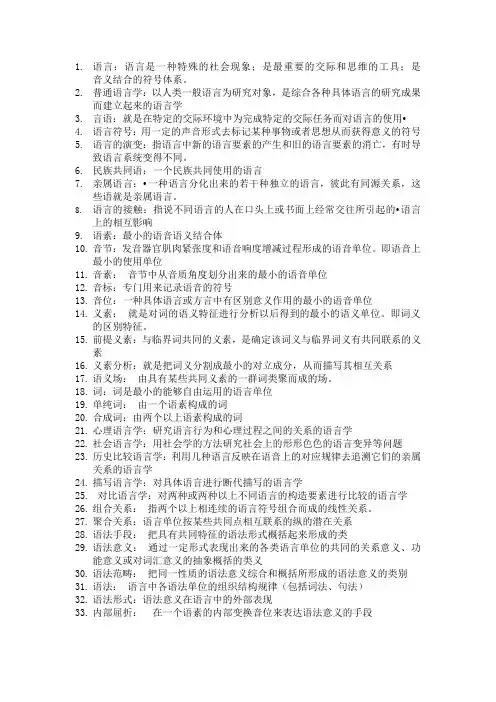
1.语言:语言是一种特殊的社会现象;是最重要的交际和思维的工具;是音义结合的符号体系。
2.普通语言学:以人类一般语言为研究对象,是综合各种具体语言的研究成果而建立起来的语言学3.言语:就是在特定的交际环境中为完成特定的交际任务而对语言的使用•4.语言符号:用一定的声音形式去标记某种事物或者思想从而获得意义的符号5.语言的演变:指语言中新的语言要素的产生和旧的语言要素的消亡,有时导致语言系统变得不同。
6.民族共同语:一个民族共同使用的语言7.亲属语言:•一种语言分化出来的若干种独立的语言,彼此有同源关系,这些语就是亲属语言。
8.语言的接触:指说不同语言的人在口头上或书面上经常交往所引起的•语言上的相互影响9.语素:最小的语音语义结合体10.音节:发音器官肌肉紧张度和语音响度增减过程形成的语音单位。
即语音上最小的使用单位11.音素:音节中从音质角度划分出来的最小的语音单位12.音标:专门用来记录语音的符号13.音位:一种具体语言或方言中有区别意义作用的最小的语音单位14.义素:就是对词的语义特征进行分析以后得到的最小的语义单位。
即词义的区别特征。
15.前提义素:与临界词共同的义素,是确定该词义与临界词义有共同联系的义素16.义素分析:就是把词义分割成最小的对立成分,从而描写其相互关系17.语义场:由具有某些共同义素的一群词类聚而成的场。
18.词:词是最小的能够自由运用的语言单位19.单纯词:由一个语素构成的词20.合成词:由两个以上语素构成的词21.心理语言学:研究语言行为和心理过程之间的关系的语言学22.社会语言学:用社会学的方法研究社会上的形形色色的语言变异等问题23.历史比较语言学:利用几种语言反映在语音上的对应规律去追溯它们的亲属关系的语言学24.描写语言学:对具体语言进行断代描写的语言学25.•对比语言学:对两种或两种以上不同语言的构造要素进行比较的语言学26.组合关系:指两个以上相连续的语言符号组合而成的线性关系。
导言1. 语言学:以语言作为研究对象的一门独立科学。
2. 专语语言学:以某一种具体的语言为研究对象的语言学。
它包括共时语言学和历时语言学两种。
总之,专语语言学只研究某一种语言。
3. 共时语言学:语言研究的一种方法,从一个横断面描写研究语言在某个历史时期的状态和发展。
4. 历时语言学:语言研究的一种方法,集中研究语言在较长历史时期中所经历的变化。
5 普通语言学:以人类一般语言为研究对象,研究人类语言的性质、结构特征、发展规律,是综合众多语言的研究成果而建立起来的语言学,是语言学的重要理论部分。
6. 语文学:是为给古代文化遗产--政治历史文学等方面的经典书面著作作注释,目的是使人们可以读懂古书的一门尚未独立的学科。
7. “小学”:中国传统的语文学,围绕阐释和解读先秦典籍来展开研究,从而诞生了分析字形的文字学、研究字音的音韵学、解释字义的训诂学,因此又被人们称为经学的附庸。
8. 应用语言学:研究语言学的应用的学科,实际上是一种交叉学科,是相关学科的学者将语言学的基本原理同有关学科结合起来研究问题而产生的新的学科。
9. 历史比较语言学:语言学中一个重要的部门,它以历史比较法为基础,研究语言的亲属关系。
它为现代语言学的建立奠定了坚实的基础,是语言学走上独立发展道路的标志。
第一章语言的社会功能1. 语言:是一种特殊的社会现象,是人类作为必不可少的思维工具和最重要的交际工具来使用的一种音义结合的符号系统。
2. 说话:运用语言跟人们交流思想的行为,本身不等于语言。
3. 言语:是对语言的运用,它有两个意思:一是指人的说和写的过程,是人的一种行为,叫言语活动,也叫言语行为;一是指人说出来的话,写出来的东西,也叫言语作品。
4. 交际工具:人类交际活动所使用的工具。
语言是人类最重要的交际工具。
此外,身势等伴随动作是非语言的交际工具;旗语之类是建立在语言、文字基础上的辅助**际工具;文字是建立在语言基础之上的一种最重要的辅助交际工具;5. 思维:是认识现实世界时的一种动脑筋的过程,也指动脑筋时进行比较、分析、综合以认识现实的能力。
语言学名词解释汇总
以下是一些语言学常用的术语及其解释:
1. 语言:人类特有的沟通工具,通过语音或其他形式传递信息。
2. 语音:语言中的声音单元,用来进行交流和表达意思。
3. 语法:语言中组织和表达意义的结构体系。
4. 词汇:语言中的单词和词组。
5. 语义学:研究词汇和句子的意义和推理。
6. 句法:语言中句子的结构和组成方式。
7. 语用学:研究语言使用的情境和目的。
8. 方言:语言的地区变体。
9. 双关语:一个词或短语在不同语境中具有不同的意义。
10. 偏见:对某些人群或事物的主观偏好或偏见。
11. 语音学:研究语音的产生、传播和感知的学科。
12. 语素:一个词中最小的有意义的单位。
13. 外语:一个人不作为母语使用的语言。
14. 语义角色:句子中表示动作的参与者和受益者的角色。
15. 同音异义词:发音相同但意义不同的词。
16. 语体:语言在不同社会和文化环境下的变体。
17. 口音:由不同语音特征引起的发音差异。
18. 父语:一个人从小学习和使用的第一种语言。
19. 旁观者理论:社会心理学概念,指的是观察者对特定语言
和文化的理解。
20. 叙事学:研究叙述结构和故事生成的学科。
这只是一些常用的语言学术语,语言学是一个非常广泛的学科,还有很多其他的术语可供学习和研究。
导言部分1.语言:语言是一个音义结合的符号系统,是人类独有的、最重要的交际工具,同时也是思维工具。
2.语言学:语言学是以人类语言作为研究对象的学科,研究人类语言的性质、结构、发展及其在社会生活中的运用以及语言研究成果的应用问题,等等。
分理论语言学和应用语言学两个领域。
3.语文学:人类最早的语言研究是从解释古代文献开始的,是为了研究哲学、历史和文学而研究语言的。
我们把这种依附于其他学科存在的语言研究成为语文学。
4.“小学”:在中国古代,小学先从教授字的形(六书)、音、义开始,就把研究文字、训诂、音韵方面的学问统称为小学。
小学一直是经学的一部分,包括音韵学、训诂学、文字学三个分支学科。
5.理论语言学:普通语言学的一个部分,与应用语言学相对。
主要以语言系统的描写、语言运用机制、语言能力以及语言发展的历史为主要的研究对象。
第一章语言的社会功能1.语言的两个有限:任何一种语言都是一个音义结合的符号系统,其中作为基本符号的语素和词在数量上是有限的,把语素或词组合起来构成词组或句子的规则也是有限的。
语言的这两个有限性是区别言语活动的基本特征。
2.言语活动的两个无限:言语活动是以语言为工具展开的交际或思维活动,其中作为这个活动的最基本的单位——句子,在理论上可以是无限长的,在数量上可以是是无限多的。
3.大脑左右半球分工:人类大脑左右半球分工不同,左脑主管语言、逻辑、书写及右侧肢体运动,而右脑主管色彩、空间感、节奏和左侧肢体运动。
大脑两半球分工是人类特有的,但出生婴儿大脑两半球没有分工。
4.非语言交际工具或副语言交际工具:人们在运用语言进行交际的时候,不但动嘴,而且脸部的表情、手的动作、乃至整个躯体的姿态等非语言的东西也都参加进来。
我们这些非语言的交际工具称为副语言交际工具。
副语言交际工具的使用范围非常有限,只能起辅助性的交际作用,以补充语言交际的某些不足。
5.辅助性交际工具:指的文字、旗语、电报代码等在语言的基础上产生的交际工具。
语言学:顾名思义是研究语言的科学,语言是语言学的研究对象。
个别语言学:以某中见体语言作为研究对象的语言学叫做个别语言学又叫具体语言学。
汉语语言学、英语语言学、日语语言学都属于这一类。
普通语言学:以人类语言作为研究对象,探索各种语言共有的规律,以及各种语言在结构上的共同特点等,人类语言中共性的东西的语言学叫做普通语言学又叫一般语言学。
一般语言学划分为语音学、语义学、词汇学、语法学、风格学、修辞学,属于一般语言学。
历时语言学:研究某种语言在不同阶段的历史演变的语言学叫做历时语言学。
如:汉语史。
共时语言学:截取某种语言在历史发展中的某一阶段,做一个横断面剖析的语言学叫共时语言学。
如:汉语史。
比较语言学:用比较的方法对不同的语言进行对比研究,找出他们之间异同的语言学。
如汉英比较语言学。
历史语言学:运用比较的方法,来发现几种语言在历史演变过程中对应规律,从而拟测语言的亲属关系的语言学叫做历史语言学。
如汉藏语言学,印欧语言学。
感性思维:两种,狭义的感性思维:指运用感觉器官,感受到外界事物的活动。
它的特点是用感觉器官直接的感知思维对象,并通过思维的活动去影响思维对象。
包括:视觉和听觉嗅觉、触觉、知觉都属于它。
广义的感性思维:除了包括侠义的感性思维,还包括在头脑中唤起表象并在头脑中对表象进行加工改造的活动,这种思维加工叫表象思维。
抽象思维:又叫理性思维又叫逻辑思维指:从概念判断和推理逻辑形式进行的思维活动概念是用语言的词来表达的,判断是用语言的句子来表达的推理。
也是借助句子来表达的因此以语言为工具或语言的基础进行的活动。
因为语言是人类独自的能力,所以动物没有抽象思维。
如:老马识途,狐狸断运、黑猩猩学手语。
人有人言兽有兽语,语言是抽象思维的必要形式,但并不是抽象思维的唯一形式。
发散思维:1、也叫外思维活动,指随着感性认识和理性认识而产生的综合的心理活动。
如感情,意志,美感,文化传统等都属于文化思维。
对于下大雨这一现象人的情感不一样。
《语言学》名词解释阅读:16312009-10-2310:07标签:杂谈1、言语:个人说的行为和结果,包括说话这种动作以及说出来的话。
2、语言:是人的发音器官发出来的能够代表一定意义的符号系统。
3、组合关系:一个语言单位和前一个或后一个语言单位,或和前后两个语言单位之间的关系叫做组合关系,也就是“句段关系”。
它体现在互相关联的语言单位组成的整体中。
4、自主性:就是语言系统内部的现象和现象之间的规律都可以通过语言系统本身来加以解释,而不需要向外界去寻找解释的理由。
5、普通语言学:语言学界把研究人类社会的语言这种社会现象的一般理论称为普通语言学,它以一般语言为研究对象,探索各种语言所共有的特性,共同的规律、结构上的共同特点以及一般原理。
6、个别语言学:是研究个别语言的结构体系和结构规则的语言学分支,如汉语言学、美语语言学。
7、符号:指的是根据社会的约定俗成使用某种特定的物质实体来表示某种特定意义而形成的这种实体和意义的结合体。
8、超音段音位:也叫非音质音位,它指的是以音高、音强、音长来区别意义的单位,分别叫何等调味、重位和时位。
9、语调:与全句的意思以及说话人的情感、态度相关的全句的高低、长短、强弱等方面的变化。
10、语音:是指语言的物质外壳,是由人的发音器官发出的,负载着一定的意义,并作为语言符号系统载体的声音。
11、音位:是从社会功能的角度划分出来的语音单位,它是特定语言或方言中具有区别意义作用的最小的语音单位。
12、音位变体:同属于一个音位的不同音素就叫做音位变体。
13、音质音位:以音素为材料,通过音质的差别来起辩义作用的音位。
14、音节:是听觉上最自然,也就是最容易分辨最小语音单位,也是音位和音位组合构成的最小的语音结构单位。
15、音渡:人们说话时,音位与音位,音节与音节连成一串,形成前后相连续的语流,这些语音单元在前后过渡,相互连接时,会因为自身性质的不同而采取不同过渡和连接方式,这些方式叫做“音渡”又叫“音联”。
Chapter 1: Introduction1. Linguistics: Linguistics is generally defined as the scientific study of language.8. langue: Lange refers to the abstract linguistic system shared by all the members of aspeech community.9. parole :Parole refers to the realization of langue in actual use.10. competence : The ideal user’s knowledge of the rules of his language.11.performance : The actual realization of this knowledge in linguistic communication.12. language : Language is a system of arbitrary vocal symbols used for human communication.13.design features : Design features refer to the defining properties of humanlanguage that distinguish it from any animal system of communication.14. arbitrariness: Arbitrariness refers to no logical connection between meaning andsound.15. productivity: Users can understand and produce sentences t hat they have neverheard before.16. duality: Language consists of two sets of structure, with lower lever of sound,which is meaningless, and the higher lever of meaning.17. displacement: Language can be used to refer to the contexts removed from theimmediate situation of the speaker no matter how far away from the topic ofconversation in time or space.18. cultural transmission: Language is culturally transmitted. It is taught and learnedfrom one generation to the next, rather than by instinct.Chapter 2: Phonology1. phonic medium : The meaningful speech sound in human communication.2. phonetics : The study of phonic medium of language and it is concerned with allsounds in t he world’s languages.3. articulatory phonetics : It studies sounds from the speaker’s point of view, i.e. ha speaker uses his speech organs to articulate the sounds.the4. auditory phonetics: The studies sounds from the hearer’s point of view, i.e. how sounds are perceived by the hearer.5. acoustic phonetics: It studies the way sounds travel by looking at the sound waves,the physical means by which sounds are transmitted through the air from one personto another.6. voicing: the way that sounds are produced with the vibration of the vocal cords.7. voiceless: the way that sounds are produced with no vibration of the vocal cords.8. broad transcription: The use of letter symbols only to show the sounds or soundssequences in written form.9. narrow transcription: The use of letter symbol, together with the diacritics to showsounds in written form.10. diacritics: The symbols used to show detailed articulatory features of sounds.11. IPA: short for International Phonetic Alphabets, a system of symbols consists ofletters and diacritics, used to represent the pronunciation of words in any language.12. aspiration: A little puff of air that sometimes follows a speech sound.13. manner of articulation : The manner in which obstruction is created.14. place of articulation : The place where obstruction is created.15. consonant: a speech s ound in which the air stream is obstructed in one way or another.16. vowel : a speech sound in which the air stream from the lung meets with no obstruction.17. monophthong : the individual vowel.18. diphthong : The vowel which consists of two individual vowels, and functions as a single one.19. phone : The speech sound we use when speaking a language.20. phoneme : The smallest unit of sound in a language which can distinguish two sounds.21. allophone : any different forms of the same phoneme in different phonetic environments.22. phonology : The description of sound systems of particular languages and how sounds function to distinguish meaning.23. phonemic contrast : two similar sounds occur in the same environment and distinguish meaning.24. complementary distribution : allophones of the same phoneme and they don’t distinguish meaning but complement each other in distribution.25. minimal pair: two different forms are identical in every way except one sound and occurs in the same position. The two sounds are said to form a minimal pair.26. sequential rules: The rules to govern the combination of sounds in a particular language.27. assimilation rule: The rule assimilates one sound to another by copying a featureof a sequential phoneme, thus making the two phones similar.28. deletion rule: The rule that a sound is to be deleted although it is orthographically represented.29. suprasegmental features: The phonemic features that occur above the level of the segments----syllable, word, sentence.30. tone: Tones are pitch variations, which are caused by the differing rates of vibration of the vocal cords.31. intonation: When pitch, stress and sound length are tied to the sentence rather than the word in isolation, they are collectively known as intonation.Chapter 3: Morphology1. morphology: A branch of linguistics that studies the internal structure of words and rules for word formation.2. open class: A group of words, which contains an unlimited number of items, and new words can be added to it.3. closed class: A relatively few words, including conjunctions, prepositions and pronouns, and new words are not usually added to them.4. morpheme: The smallest unit of meaning of a language. It can not be divided without altering or destroying its meaning.5. affix: a letter or a group of letter, which is added to a word, and which changes themeaning or function of the word, including prefix, infix and suffix.6. suffix: The affix, which is added to the end of a word, and which usually changesthe part of speech of a word.7. prefix: The affix, which is added to the beginning of a word, and which usuallychanges the meaning of a word to its opposite.8. bound morpheme: Morpheme that can not be used alone, and it must be combinedwit others. E.g. –ment.9. free morpheme: a morpheme that can stand alone as a word.10. derivational morpheme: Bound morpheme, which can be added to a stem to forma new word.11. inflectional morpheme: A kind of morpheme, which are used to make grammatical categories, such as number, tense and case.12. morphological rules: The ways words are formed. These rules determine howmorphemes combine to form words.13. compound words: A combination of two or more words, which functions as asingle words14. inflection: the morphological process which adjusts words by grammatical modification, e.g. in The rains came, rain is inflected for plurality and came for pasttense.Chapter 4: Syntax1. syntax: A branch of linguistics that studies how words are combined to formsentences and the rules that govern the formation of sentences.2. category: It refers to a group of linguistic items which fulfill the same or similarfunctions in a particular language such as a sentence, a noun phrase or a verb.6. phrase: syntactic units that are built around a certain word category are calledphrase, the category of which is determined by the word category around which thephrase is built.8. head: The word round which phrase is formed is termed head.9. specifier: The words on the left side of the heads are said to function as specifiers.10. complement: The words on the right side of the heads are complements.11. phrase structure rule: The special type of grammatical mechanism that regulatesthe arrangement of elements that make up a phrase is called a phrase structure rule.14. coordination: Some structures are formed by joining two or more elements of thesame type with the help of a conjunction such as and or or. Such phenomenon isknown as coordination.15. subcategorization: The information about a word’s complement is included in the head and termed suncategorization.16. complementizer: Words which introduce the sentence complement are termed complementizer.17. complement clause: The sentence i ntroduced by the complementizer is called acomplement clause.18. complement phrase: the elements, including a complementizer and a complementclause is called a complement phrase.19. matrix clause: the contrusction in which the complement phrase is embedded iscalled matrix clause.20. modifier: the element, which specifies optionally expressible properties of headsis called modifier.21. transformation : a special type of rule that can move an element from one position to another22. inversion : the process of transformation that moves the auxiliary from the Infl position to a position to the left of the subject, is called inversion.23. Do insertion : In the process of forming yes-no question that does not contain an overt Infl, interrogative do is inserted into an empty Infl positon to make transformation work.24. deep structure : A level of abstract syntactic representation formed by the XP rule.25. surface structure : A level of syntactic representation after applying the necessary syntactic movement, i.e., transformation, to the deep structure. (05)26. universal grammar: the innateness principles and properties that pertain to the grammars of all human languages.Chapter 5: Semantics1. semantics: Semantics can be simply defined as the study of meaning.3. sense : Sense is concerned with the inherent meaning of the linguistic form. It is the collection of all the features of the linguistic form. It is abstract and de-contexturalized. It is the aspect of meaning dictionary compilers are interested in.4. reference : Reference means what a linguistic form refers to in the real, physical world. It deals with the relationship between the linguistic element and the non-linguistic world of experience.5. synonymy: Synonymy refers to the sameness or close similarity of meaning. Words that are close in meaning are called synonyms.6. dialectal synonyms: synonyms that are used in different regional dialects.7. stylistic synonyms: synonyms that differ in style, or degree of formality.8. collocational synonyms: Synonyms that differ in their colllocation, i.e., in the words they go together with.9. polysemy : The same word has more than one meaning.10. homonymy: Homonymy refers to the phenomenon that words having different meanings have the same form, i.e., different words are identical in sound or spelling, or in both.11. homophones: When two words are identical in sound, they are homophones.12. homographs: When two words are identical in spelling, they are homographs.13. complete homonymy: When two words are identical in both sound and spelling, they are complete homonyms.14. hyponymy: Hyponymy refers to the sense relation between a more general, more inclusive word and a more specific word.15. superordinate: The word which is more general in meaning is called the superordinate.16. co-hyponyms: Hyponyms of the same superordinate are co-hyponyms.17. antonymy: The term antonymy is used for oppositeness of meaning.20. relational opposites: Pairs if words that exhibit the reversal of a relationshipbetween the two items are called relational opposites. For example, husband---wife,father---son, buy---sell, let---rent, above---below.21. entailment: the relationship between two sentences w here the truth of one isinferred from the truth of the other. E.g. Cindy killed the dog entails the dog is dead.22. presupposition: What a speaker or writer assumes that the receiver of the massagealready knows. e.g. Some tea has already been taken is a presupposition of Take somemore tea.Chapter 6: Pragmatics1. pragmatics: The study of how speakers uses sentences to effect successful communication.2. context: The general knowledge shared by the speakers and the hearers.3. sentence meaning: The meaning of a self-contained unit with abstract andde-contextualized features.4. utterance meaning: The meaning that a speaker conveys by using a particularutterance in a particular context.5. utterance: expression produced in a particular context with a particular intention.6. Speech Act Theory: The theory proposed by John Austin and deepened by Searle,which believes that we are performing actions when we are speaking.7. constatives: Constatives are statements t hat either state or describe, and are thusverifiable.8. performatives: Pe rformatives are sentences that don’t state a fact or describe a state, and are not verifiable.9. locutionary act: The act of conveying literal meaning by virtue of syntax, lexiconand phonology.ntention and performed in10. illocutionary act: The act of expressing the speaker’s isaying something.11. perlocutionary act: The act resulting from saying something and the consequenceor the change brought about by the utterance.12. representatives: Stating or describing, saying what the speaker believes to be true.13. directives: Trying to get the hearer to do something.17. cooperative Principle: The principle that the participants must first of all bewilling to cooperate in making conversation, otherwise, it would be impossible tocarry on the talk.18. conversational implicature: The use of conversational maxims to imply meaningduring conversation.Chapter 7: Language Change8. acronyms: Acronyms are words derived from the initials of several words.9. protolanguage: The original form of a language family, which has ceased to exist.10. Language family: A group of historically related languages that have developedfrom a common ancestral language.Chapter 8: Language And Society1. sociolinguistics: The subfield of linguistics that study language variation andlanguage use in social contexts.2. speech community: A group of people who form a community and share at leastone speech variety as well as similar linguistic norms.3. speech varieties: It refers to any distinguishable form of speech used by a speakeror a group of speakers.4. regional dialect: A variety of language used by people living in the same geographical region.5. sociolect: A variety of language used by people, who belong to a particular socialclass.6. registers : The type of language which is selected as appropriate to the type of situation.dialect of an individual speaker that combines elements,7. idiolect : A person’sregarding regional, social, gender and age variations.8. linguistic reportoire : The totality of linguistic varieties possessed by an individualconstitutes his linguistic repertoire.9. register theory : A theory proposed by American linguist Halliday, who believedthat three social variables determine the register, namely, field of discourse, tenor ofdiscourse and mode of discourse.10. field of discourse : the purpose and subject matter of the communicative behavior..11. tenor of discourse: It refers to the role of relationship in the situation in question:who the participants in the communication groups are and in what relationship theystand to each other.12. mode of discourse: It refers to the means of communication and it is concernedwith how communication is carried out.13. standard dialect: A superposed variety of language of a community or nation,usually based on the speech and writing of educated native speakers of the language.14. formality: It refers to the degree of formality in different occasions and reflects the relationship and conversations. According to Martin Joos, there are five stages of formality, namely, intimate, casual, consultative, formal and frozen.15. Pidgin: A blending of several language, developing as a contact language ofpeople, who speak different languages, try to communication with one another on aregular basis.16. Creole : A pidgin language which has become the native language of a group ofspeakers used in this daily life.17. bilingualism : The use of two different languages side by side with each having adifferent role to play, and language switching occurs when the situation changes.(07C)18. diaglossia : A sociolinguistic situation in which two different varieties of languageco-exist in a speech community, each having a definite role to play.19. Lingua Franca : A variety of language that serves as a medium of communicationamong groups of people, who speak different native languages or dialects20. code-switching: the movement back and forth between two languages or dialectswithin the same sentence or discourse.Chapter 10: Language Acquisition1. language acquisition: It refers to the child’s acquisition of his mother tongue, i.e. how the child comes to understand and speak the language of his community.2. language acquisition device (LAD): A hypothetical innate mechanism every normalhuman child is believed to be born with, which allow them to acquire language.3. Universal Grammar: A theory which claims to account for the grammatical competence of every adult no matter what language he or she speaks.4. motherese: A special speech to children used by adults, which is characterized with slow rate of speed, high pitch, rich intonation, shorter and simpler sentence structures etc.----又叫child directed speech,caretaker talk.5. Critical Period Hypothesis: The hypothesis that the time span between early childhood and puberty is the critical period for language acquisition, during which children can acquire language without formal instruction successfully and effortlessly.6. under-extension: Use a word with less than its usual range of denotation.7. over-extension: Extension of the meaning of a word beyond its usual domain of application by young children.8. telegraphic speech: Childre n’s early multiword speech that contains content words and lacks function words and inflectional morphemes.9. content word: Words referring to things, quality, state or action, which have lexical meaning used alone.10. function word: Words with little meaning on their own but show grammatical relationships in and between sentences.11. taboo: Words known to speakers but avoided in some contexts of speech for reasons of religion, politeness etc.12. atypical development: Some acquisition of language may be delayed but followthe same rules of language development due to trauma or injury.Chapter 11 : Second Language Acquisition1. second language acquisition: It refers to the systematic study of how one person acquires a second language subsequent to his native language.2. target language: The language to be acquired by the second language learner.3. second language: A second language is a language which is not a native language ina country but which is widely used as a medium of communication and which is usually used alongside another language or languages.4. foreign language: A foreign language is a language which is taught as a school subject but which is not used as a medium of instruction in schools nor as a language of communication within a country.5. interlanguage: A type of language produced by second and foreign language learners, who are in the process of learning a language, and this type of language usually contains wrong expressions.6. fossilization: In second or foreign language learning, there is a process which sometimes occurs in which incorrect linguistic features become a permanent part ofthe way a person speaks or writes a language.14. overgeneralization: The use of previously available strategies in new situations, in which they are unacceptable.15. cross-association: s ome words are similar in meaning as well as spelling and pronunciation. This internal interference is called cross-association.16. error: the production of incorrect forms in speech or writing by a non-native speaker of a second language, due to his incomplete knowledge of the rules of thattarget language.17. mistake: mistakes, defined as either intentionally or unintentionally deviant formsand self-corrigible, suggest failure in performance.18. input: language which a learner hears or receives and from which he or she canlearn.19. intake: the input which is actually helpful for the learner.20. Input Hypothesis: A hypothesis proposed by Krashen , which states that in secondor the learner to understand input language whichlanguage learning, it’s necessary fpresent linguisticcontains linguistic items that are slightly beyond the learner’scompetence. E ventually the ability to produce language is said to emerge naturallywithout being taught directly.21. acquisition: Acquisition is a process similar to the way children acquire their firstlanguage. It is a subconscious process without minute learning of grammatical rules.Learners are hardly aware of their learning but they are using language to communicate. It is also called implicit learning, informal learning or natural learning.23. comprehensible input: Input language which contains linguistic items that aresent linguistic competence.slightly beyond the learner’s pre24. language aptitude: the natural ability to learn a language, not includingintelligence, motivation, interest, etc.25. motivation: motivation is defined as the learner’s attitudes and affective state or learning drive.26. instrumental motivation: the motivation that people learn a foreign language forinstrumental goals such as passing exams, or furthering a career etc.27. integrative motivation: the drive that people learn a foreign language because ofthe wish to identify with the target culture.28. resultative motivation: the drive that learners learn a second language for externalpurposes.29. intrinsic motivation: the drive that learners learn the second language forenjoyment or pleasure from learning.Chapter 12 : Language And Brain1. neurolinguistics: It is the study of relationship between brain and language. Itincludes research into how the structure of the brain influences language learning,how and in which parts of the brain language is stored, and how damage to the brainaffects the ability to use language.2. psycholinguistics: the study of language processing. It is concerned with theprocesses of language acqisition, comprehension and production.7. aphasia: It refers to a number of acquired language disorders due to the cerebrallesions caused by a tumor, an accident and so on.13. spoonerism: a slip of tongue in which the position of sounds, syllables, or words isreversed, for example, Let’s have chish and fips instend of Let’s have fish and ch 14. priming: the process that before the participants make a decision whether thestring of letters is a word or not, they are presented with an activated word.15. frequency effect: Subjects take less time to make judgement on frequently usedwords than to judge less commonly used words . This phenomenon is calledfrequency effect.16. lexical decision: an experiment that let participants judge whether a string of letter is a word or not at a certain time.18. priming effect: Since the mental representation is activated through the prime, when the target is presented, r esponse time is shorter that it otherwise would have been. This is called the priming effect.。